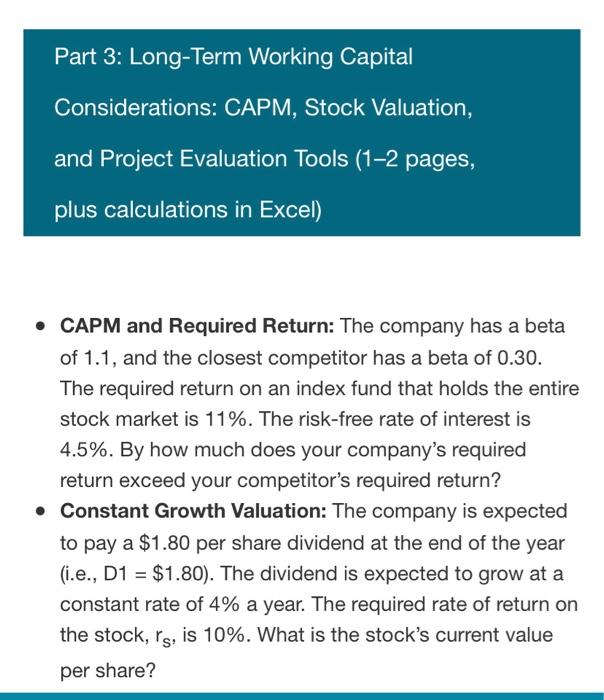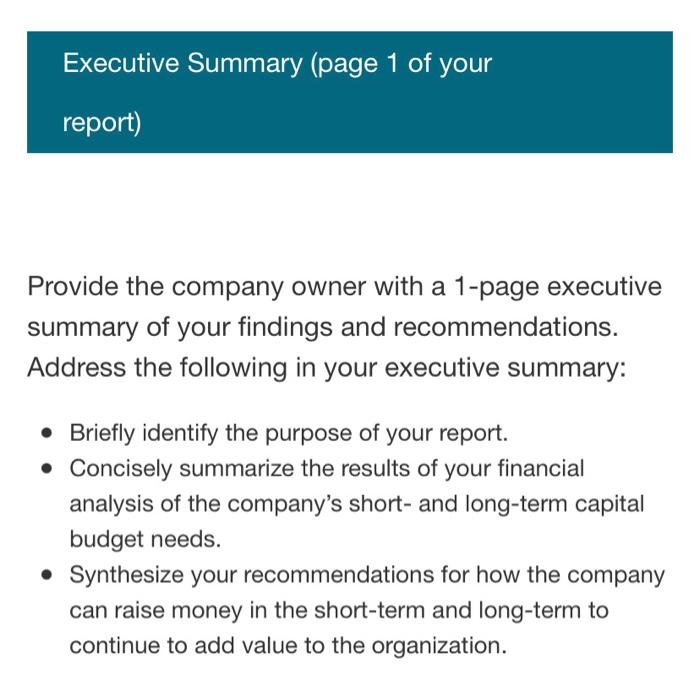Answered step by step
Verified Expert Solution
Question
1 Approved Answer
please answer all questions. please create an excutive summary as well. please answer all questions Part 3: Long-Term Working Capital Considerations: CAPM, Stock Valuation, and
please answer all questions. please create an excutive summary as well. 







please answer all questions
Part 3: Long-Term Working Capital Considerations: CAPM, Stock Valuation, and Project Evaluation Tools (1-2 pages, plus calculations in Excel) - CAPM and Required Return: The company has a beta of 1.1, and the closest competitor has a beta of 0.30 . The required return on an index fund that holds the entire stock market is 11%. The risk-free rate of interest is 4.5%. By how much does your company's required return exceed your competitor's required return? - Constant Growth Valuation: The company is expected to pay a $1.80 per share dividend at the end of the year (i.e., D1 = \$1.80). The dividend is expected to grow at a constant rate of 4% a year. The required rate of return on the stock, rs, is 10%. What is the stock's current value per share? - Nonconstant Growth Valuation: The company recently paid a dividend, D0, of $2.75. It expects to have nonconstant growth of 18% for 2 years followed by a constant rate of 6% thereafter. The firm's required return is 12%. - How far away is the horizon date? - What is the firm's horizon, or continuing, value? - What is the firm's intrinsic value today, P0 ? - Weighted Average Cost of Capital: The company has a target capital structure of 35% debt and 65% common equity, with no preferred stock. Its before-tax cost of debt is 8%, and its marginal tax rate is 40%. The current stock price is P0=$22.00. The last dividend was D0= $2.25, and it is expected to grow at a 5% constant rate. What is its cost of common equity and its WACC? - Capital Budgeting Criteria: The company has an 11% WACC and is considering two mutually exclusive investments (that cannot be repeated) with the following cash flows: - What is each project's NPV? - What is each project's IRR? - What is each project's MIRR? (Hint: Consider Period 7 as the end of Project B's life.) - From your answers to parts a, b, and c, which project would be selected? If the WACC was 18%, which project would be selected? - Construct NPV profiles for Projects A and B. - Calculate the crossover rate where the two projects' NPVs are equal. - What is each project's MIRR at a WACC of 18% ? Provide the company owner with a 1-page executive summary of your findings and recommendations. Address the following in your executive summary: - Briefly identify the purpose of your report. - Concisely summarize the results of your financial analysis of the company's short- and long-term capital budget needs. - Synthesize your recommendations for how the company can raise money in the short-term and long-term to continue to add value to the organization. Part 3: Long-Term Working Capital Considerations: CAPM, Stock Valuation, and Project Evaluation Tools (1-2 pages, plus calculations in Excel) - CAPM and Required Return: The company has a beta of 1.1, and the closest competitor has a beta of 0.30 . The required return on an index fund that holds the entire stock market is 11%. The risk-free rate of interest is 4.5%. By how much does your company's required return exceed your competitor's required return? - Constant Growth Valuation: The company is expected to pay a $1.80 per share dividend at the end of the year (i.e., D1 = \$1.80). The dividend is expected to grow at a constant rate of 4% a year. The required rate of return on the stock, rs, is 10%. What is the stock's current value per share? - Nonconstant Growth Valuation: The company recently paid a dividend, D0, of $2.75. It expects to have nonconstant growth of 18% for 2 years followed by a constant rate of 6% thereafter. The firm's required return is 12%. - How far away is the horizon date? - What is the firm's horizon, or continuing, value? - What is the firm's intrinsic value today, P0 ? - Weighted Average Cost of Capital: The company has a target capital structure of 35% debt and 65% common equity, with no preferred stock. Its before-tax cost of debt is 8%, and its marginal tax rate is 40%. The current stock price is P0=$22.00. The last dividend was D0= $2.25, and it is expected to grow at a 5% constant rate. What is its cost of common equity and its WACC? - Capital Budgeting Criteria: The company has an 11% WACC and is considering two mutually exclusive investments (that cannot be repeated) with the following cash flows: - What is each project's NPV? - What is each project's IRR? - What is each project's MIRR? (Hint: Consider Period 7 as the end of Project B's life.) - From your answers to parts a, b, and c, which project would be selected? If the WACC was 18%, which project would be selected? - Construct NPV profiles for Projects A and B. - Calculate the crossover rate where the two projects' NPVs are equal. - What is each project's MIRR at a WACC of 18% ? Provide the company owner with a 1-page executive summary of your findings and recommendations. Address the following in your executive summary: - Briefly identify the purpose of your report. - Concisely summarize the results of your financial analysis of the company's short- and long-term capital budget needs. - Synthesize your recommendations for how the company can raise money in the short-term and long-term to continue to add value to the organization Step by Step Solution
There are 3 Steps involved in it
Step: 1

Get Instant Access to Expert-Tailored Solutions
See step-by-step solutions with expert insights and AI powered tools for academic success
Step: 2

Step: 3

Ace Your Homework with AI
Get the answers you need in no time with our AI-driven, step-by-step assistance
Get Started


